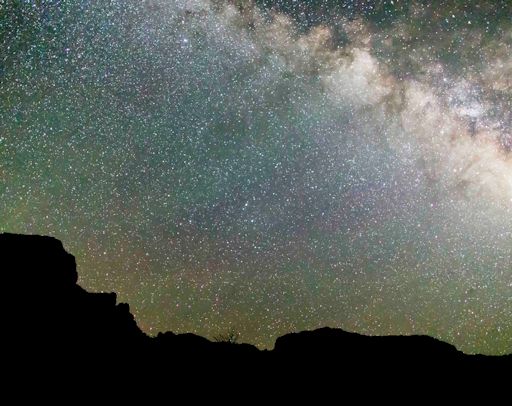What's in the sky tonight?
July 12, 2013
-The crescent Moon, faint Regulus, and bright Venus form a curving line low in the western twilight, as shown below.
-Not all colorful lights in the sky are the aurora borealis. The green light in the picture below is called "airglow." Airglow is a luminous bubble that surounds our entire planet, fringing the top of the atmosphere with aurora-like color. Although airglow resembles the aurora borealis, its underlying physics is different. Airglow is caused by an assortment of chemical reactions in the upper atmosphere driven mainly by solar ultraviolet radiation; auroras, on the other hand, are ignited by gusts of solar wind. Green airglow is best photographed from extremely dark sites on nights when the Moon is new or below the horizon. It often shows up in long exposures of the Milky Way: more airglow.Astrophotographer Kenneth Edwards discovered this for himself on July 4th when he was taking a long exposure of the Milky Way over Big Bend National Park, Texas:

 Astro Picture of the Day:
July 12, 2013
Source:
Astro Picture of the Day:
July 12, 2013
Source:
This fifteen degree wide field of view stretches across the crowded starfields of Sagittarius toward the center of our Milky Way galaxy. In fact, the center of the galaxy lies near the right edge of the rich starscape and eleven bright star clusters and nebulae fall near the center of the frame. All eleven are numbered entries in the catalog compiled by 18th century cosmic tourist Charles Messier. Achieving celebrity status for skygazers, M8 (Lagoon), M16 (Eagle), M17 (Omega), and M20 (Trifid) show off the telltale reddish hues of emission nebulae associated with star forming regions. But also eye-catching in small telescopes are star clusters in the crowded region; M18, M21, M22, M23, M25, and M28. Broader in extent than the star clusters themselves, M24 is actually a cloud of the Milky Way's stars thousands of light-years long, seen through a break in the galaxy's veil of obscuring dust. You can put your cursor over the image (or click here) for help identifying Messier's eleven.